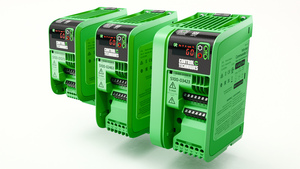
 |
Charlotte Stonestreet
Managing Editor |
| Home> | DRIVES & MOTORS | >Variable Speed Drives | >Drives: When to keep it simple |
Drives: When to keep it simple
29 July 2022
Drives regulate motor behaviour in a wide range of sophisticated applications. But drives - and the systems they support - don’t have to be complex. Even simple applications can benefit from drive control; and there are some very accessible simple drives on the market, as this article written in collaboration with Roxana Suteu identifies

NOT EVERY motorised application calls for the kind of high-performance, high-precision capabilities we associate with, say, the food or car manufacturing industries. There, machine movement often has to be exact to the millimetre (or less) - and command signals sent by drive to motor in a powerful servo system control speed, torque and position accordingly.
Such functionality is impressive, but by no means always necessary. Unlike a pick-and-place robotic arm, for example, a simple pump or fan or conveyor does not need to move through a complex path on multiple axes. Many machines, in essence, just need to start and stop, accelerating and decelerating as and when appropriate.
Variable frequency drives (VFDs) take care of this. By simply adjusting the frequency of the voltage that goes into the motor, they control motor speed in a way that delivers soft starts and smooth ramps up and down from specified velocities.
Such smoothness is one reason why VFDs are recommended for use in moving applications that – on the face of it – seem to require little more than turning on and off. VFDs protect both the material the machine is handling (because, for example, the conveyor belt doesn’t jerk and shudder) and the workings of the machine itself (which aren’t subjected to sudden stresses).
The other virtue that VFDs bring to even the most basic machine operations is the energy savings they represent. A motor whose speed can be made to match the requirements of its workload is a motor that eliminates unnecessary work – and this can easily translate into savings of 20% or 30% in terms of energy consumption.
An increasingly widespread appreciation of these benefits, in conjunction with a technology that continues to develop and diversify, is reflected in the size of the drives market. Both the number and the variety of VFDs currently available to the systems engineer is unprecedented.
Roxana Suteu, drives product manager at Control Techniques, illustrates this variety by pointing to the differences between the company’s Commander C series of drives and the relatively recent Commander S.
The Commander C is a compact general purpose drive. It is designed to support simple applications - from pumps, fans and compressors to winches, mixers and kneaders - and is itself simple to install physically and to commission with just a handful of parameters.
It’s also, in a number of respects, such as its onboard safety function, its onboard PLC for a basic level of application control, and its optional communications modules for extended network connectivity - a relatively sophisticated example of its kind.
But, observes Roxana, not all users will require this level of functionality; for some, the Commander S will be a better choice.
Is the Commander S - to use a new and essentially imprecise term - a ‘micro-drive’? For the moment, Roxana accepts the word’s usefulness, given the increasing need to ‘differentiate between the different levels of drives in the general purpose drive market’.
The Commander S, in place of the various features that might be found on a larger drive, offers the convenience of its small size and ease of use, being especially accessible to people whose experience of drives may be limited. (Its use of near-field technology to support user-friendly phone app interaction is part of this.)
At up to 4kW, this simple drive’s power range is obviously lower than that of the larger Commander C (up to 132kW), but it’s important to remember that if the user’s application requires no more than this, then it may be a good fit. The idea of any drive, after all, is to supply the system with an appropriate level of power.
What kind of applications might benefit from being matched to a very small drive such as this? Roxana envisages simple fan and pump arrangements with no great power requirements: residential air conditioning systems, for example; incubator cooling fans; alternatively, simple mixers in food and beverage manufacture.
But the full range of possibilities has probably not yet been realised. One of the challenges of diversification in the drives market is to identify the full potential, in terms of motion control and energy conservation, that these devices can bring to mechanised systems – no matter how simple.
Roxana Suteu is drives product manager at Control Techniques
acim.nidec.com/drives/control-techniques
Key Points
Many machines, in essence, just need to start and stop, accelerating and decelerating as and when appropriate
VFDs control motor speed in a way that delivers soft starts and smooth ramps up and down from specified velocities
The other virtue that VFDs bring to even the most basic machine operations is the energy savings they represent
- Looks good on paper
- Keeping data centres cool
- Control Techniques announces return of Commander family
- Drive users: Are you breaking the law?
- Nidec extends Commander range
- Precision & speed
- Precise Control
- New servo drive increases control potential for Ethernet-based networks
- Most efficient zone maintained
- New president at Control Techniques
- PUMPED UP PERFORMANCE
- SOFT STARTER OR VARIABLE SPEED DRIVE?
- Jeans With Less Energy
- Enhanced to Withstand Tough Environments
- Savings From Improved Torque Ratio & Efficiency
- Modular VSD
- ENERGY SAVING: AN OLD MESSAGE WITH NEW PROMISE
- Updated installation guide for power drive systems
- UK drives manufacturer seals global automation deal
- WEG motors & drives power high-efficiency air blowers



















